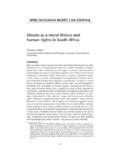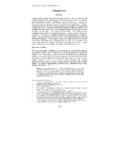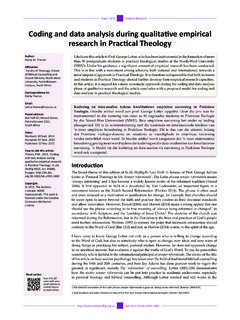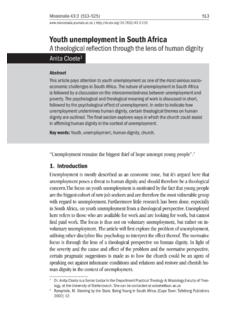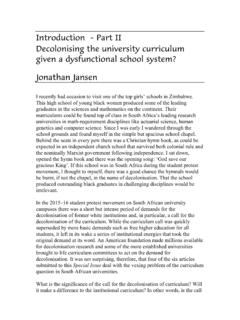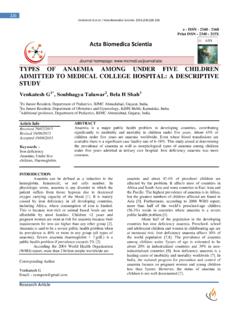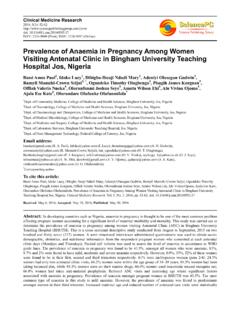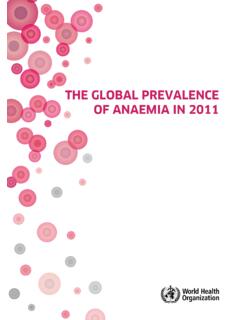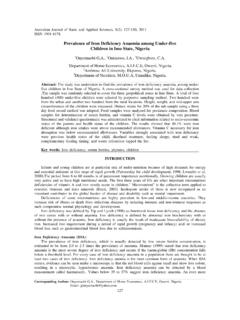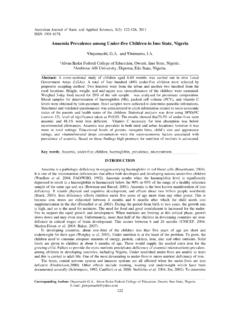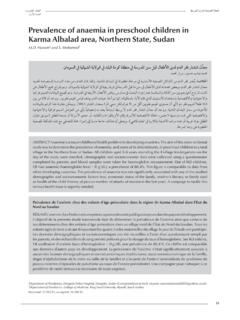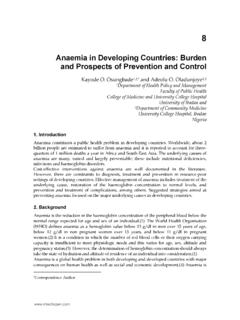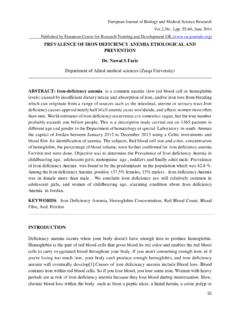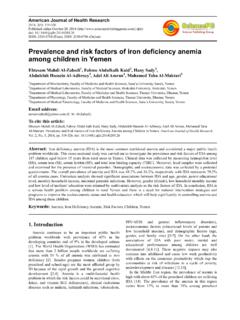Transcription of Prevalence of anaemia in pregnancy in a regional health ...
1 RESEARCH. Prevalence of anaemia in pregnancy in a regional health facility in South Africa K Tunkyi,1 MBBS, FCOG; J Moodley,1,2 MB ChB, FCOG, FRCOG, MD. 1. epartment of Obstetrics and Gynaecology, Addington Hospital, Durban, South Africa D. 2. Women's health and HIV Research Group, Department of Obstetrics and Gynaecology, Nelson Mandela School of Medicine, College of health Sciences, University of KwaZulu-Natal, Durban, South Africa Corresponding author: K Tunkyi Background. anaemia is a major global health problem affecting an estimated 42% of pregnant women worldwide . There is a paucity of South African (SA) data on anaemia in pregnancy , despite the fact that parasitic infections are endemic and the nutritional status of sections of the population is poor. Objective. To determine the Prevalence of anaemia among antenatal attendees in a regional hospital in Durban, SA. Methods. This was a cross-sectional prospective study in a regional health facility in an urban setting serving a population of low socioeconomic status.
2 Venous blood samples to perform a full blood count were obtained from antenatal attendees at their first clinic visit. Results. Two thousand pregnant women were studied; the mean (standard deviation) age and gestational age at booking was ( ). years and ( ) weeks, respectively. Eight hundred and fifty-four ( ) were anaemic (haemoglobin (Hb) levels <11 g/dL). The majority ( ) were mildly anaemic. There were five ( ) cases of severe anaemia (Hb <7 g/dL). The Prevalence of anaemia was significantly higher in HIV-positive compared with HIV-negative pregnant women ( v. ; p< ). The common morphology was normochromic normocytic (n=588, ). Conclusion. The Prevalence of anaemia was In the majority ( ) the anaemia was mild and normocytic and normochromic ( ). anaemia is a common problem among antenatal attendees in an SA urban population. S Afr Med J 2016;106(1):101-104. anaemia is a common condition globally and is Objective associated with adverse events in pregnancy .
3 [1-3] The To determine the Prevalence of anaemia at the first antenatal visit World health Organization (WHO) estimates that in a cohort of black SA women attending a regional hospital in an about 56% of pregnant women in low- and middle- urban setting. income countries (LMICs) and 23% in high-income countries are anaemic. Most cases of anaemia in women are due to Methods iron deficiency. anaemia is associated with substantial health and Ethical clearance and regulatory permission was obtained from the economic cost implications in LMICs.[1-3] University of KwaZulu-Natal Biomedical Research Ethic Committee Iron deficiency in pregnancy is probably due to the fact that (BE 306/12) and from the regional Hospital Administration. A cross- iron stores are inadequate and insufficient to meet the increased sectional prospective study over a 2-year period (2012 - 2014) was requirements in pregnancy . Iron-deficiency anaemia has been performed in a regional hospital in Durban, SA, serving a population associated with an increased risk of stillbirths, low-birth-weight with largely low socioeconomic status.
4 Written informed consent babies, intrauterine growth restriction, neonatal sepsis and maternal was obtained from consecutive women registering for antenatal care mortality.[4] and the relevant demographic and clinical data were collected in The Saving Mothers Report (2010 - 2013)[5] found that 40% a structured format. The standard practice at the study site was to of maternal deaths in South Africa (SA) were associated with perform a full blood count at the first antenatal visit and to repeat the anaemia , despite the fact that micronutrients (prophylactic iron, investigation at between 34 and 36 weeks' gestational age. All women folic acid and multivitamins) are provided routinely throughout regarded as low risk attended for prenatal care on four occasions at pregnancy . It is plausible that the anaemia associated with least during the pregnancy , while women who had risk' features were maternal mortality may be due to poor adherence in taking seen more frequently.
5 Prophylactic micronutrients and to the poor overall nutritional anaemia was defined as a haemoglobin (Hb) concentration of status of the population. <11 g/dL (WHO definition[1]). All women received prophylactic iron There is a paucity of data on anaemia among SA pregnant women, therapy (oral ferrous sulphate 200 mg) and folic acid 5 mg daily. If among whom there is high Prevalence of HIV infection. HIV is asso anaemia was present, therapeutic doses of iron (oral ferrous sulph . ciated with a high Prevalence of anaemia in sub-Saharan Africa.[6] A ate 200 mg 3 times a day) and folate 5 mg daily were prescribed with study in SA by Van Bogaert[7] found a Prevalence of anaemia of instruction on appropriate nutritional intake. This management was in a rural population. Prevalences reported from African countries standard clinical practice at the study site. indicate varying rates,[8-10] probably reflecting differing sizes of study The Hb levels were arbitrarily divided into the following groups: populations, geographical area (rural or urban), rates of parasitic (i) >11 g/dL; (ii) 10 - g/dL (mild anaemia ); (iii) 7 - g/dL.
6 Infestation and levels of education. (mod erate anaemia ); and (iv) 7 g/dL (severe anaemia ). Gestational 101 January 2016, Vol. 106, No. 1. RESEARCH. age was calculated taking into account the last menstrual period, an ultrasound dat N=2 000 patients enrolled ing scan and the symphysis-fundal height measurement. Statistical analysis N=854 ( ). Data were entered into a computer database anaemia using Microsoft Excel software and imported on SPSS (version 22) for analysis. A p-value of < was considered statistically significant. Grades of anaemia Types of anaemia Results Fig. 1 shows the Prevalence , grades and types of anaemia . Eight hundred and fifty-four Mild (n=695; ) Hypochromic microcytic (n=12; ). ( ) were anaemic. The majority ( ) Moderate (n=154; ) Normochromic normocytic (n=558; ). were mildly anaemic, whereas were Severe (n=5; ) Hypochromic normocytic (n=145; ). moderately anaemic. There were five ( ) Normochromic microcytic (n=109; ).
7 Cases of severe anaemia (Hb g/dL). The Prevalence of anaemia at booking was significantly higher in HIV-positive than in HIV and anaemia HIV-negative pregnant women (609 ( ). v. 245 ( ); p< ). Table 1 shows the relevant clinical data; Negative (n=245; ). most women were young (mean (standard Positive (n=609; ). deviation (SD)) age ( ) years) and of low parity. The mean gestational age at the Fig. 1. Prevalence , grades and types of anaemia in the study population. booking visit was 24 weeks. Table 2 shows the demographic and obstet . Table 1. The clinical data of all participants at recruitment ric data of the anaemic antenatal attendees. The data include HIV status of all participants. Total Anaemic Normal Six hundred and nine of the 845 with anaemia Variable (N=2 000) (N=854) (N=1 146) p-value 95% CI. were HIV-infected. Age (years). Table 3 shows the clinical characteristics Mean (SD) ( ) ( ) (4 .2) - and severity of anaemia ; 124 ( ) anae.
8 Range 19 - 45 19 - 28 25 - 45. mic patients were <19 years of age and 111. ( ) were aged >35 years. Six hundred and Age groups, n (%). one primigravidas and 302 grand multiparas 19 356 ( ) 124 ( ) 232 ( ) - were included in the study. anaemia was 20 - 24 377 ( ) 133 ( ) 244 ( ) - recorded in 197 primiparas and 111 grand 25 - 30 670 ( ) 295 ( ) 375 ( ) - multiparas, giving a Prevalence of and , respectively. 31 - 34 361 ( ) 191 ( ) 170 ( ) - 35 236 ( ) 111 ( ) 125 ( ) - Discussion Parity, n (%). The Prevalence of anaemia in pregnancy at 0 601 ( ) 197 ( ) 404 ( ) - the first antenatal visit in our study cohort of 2 000 pregnant women was , a 1-4 1 097 ( ) 546 ( ) 551 ( ) - result that is consistent with Prevalence rates 5 302 ( ) 111 ( ) 191 ( ) - of in Kenya,[8] in Ethiopia[9] Gestational age and in Tanzania.[10] Our sample size (weeks, 1st visit). was large and confirms that anaemia is a Mean (SD) 24 ( ) ( ) ( ) - common health problem in an SA setting.
9 There are several factors responsible for Range 16 - 32 16 - 32 28 - 30. the high Prevalence of anaemia in LMICs HIV status, n (%). such as SA: socioeconomic deprivation, Positive 943 ( ) 609 ( ) 334 ( ) - malnutrition, high incidences of malaria and Negative 1 057 ( ) 245 ( ) 812 ( ) - HIV infection, hookworm infestation, high numbers of grand multiparas, late booking, and inadequate child spacing because of lack were lower in non-Caucasian than Caucasian Vietnamese ( 1 g/dL) and women in Green . of family planning. pregnant populations from 27 gestational land ( 1 g/dL).[12] Our patients were black Recently there have been reports of differ weeks until term.[11] Further more, lower Hb South Africans of low socioeconomic status. ences in Hb levels based on racial groups. One levels have been described for population Variations in Hb concentrations obviously of these studies found that mean Hb levels groups such as African Americans ( 1 g/dL), require the establishment of reference levels 102 January 2016, Vol.
10 106, No. 1. RESEARCH. Table 2. Demographic and obstetric data of women with anaemia v. HIV status Total Variable (N=854) HIV +ve (N=609) HIV ve (N=245) p-value 95% CI. Age (years), mean (range) (14 - 45) (14 -40) (18 - 45) - Parity, median (range) 2 (1 - 6) 1 (1 - 2) 2 (1 - 6) - Gestation at booking (weeks), 22 (17 - 34) 22 (18 - 34) 22 (18 - 34) 1 - median (range). Table 3. Clinical data and severity of anaemia Mild anaemia Moderate anaemia Severe anaemia (Hb 10 - g/dL) (Hb 7 - g/dL) (Hb <7 g/dL). Variables Total (N=854) (N=695) (N=154) (N=5) p-value 95% CI. Age groups, n (%). 19 124 ( ) 90 ( ) 34 ( ) 0 ( ) - 20 - 24 133 ( ) 107 ( ) 26 ( ) 0 ( ) - 25 - 30 295 ( ) 259 ( ) 36 ( ) 0 ( ) - 31 - 34 191 ( ) 153 ( ) 37 ( ) 1 ( ) - 35 111 ( ) 86 ( ) 21 ( ) 4 ( ) - Parity, n (%). 0 197 ( ) 153 ( ) 44 ( ) 0 ( ) - 1-4 546 ( ) 496 ( ) 49 ( ) 1 ( ) - 5 111 ( ) 46 ( ) 61 ( ) 4 ( ) - HIV status, n (%). Negative 245 ( ) 189 ( ) 54 ( ) 2 (40) - Positive 609 ( ) 506 ( ) 100 ( ) 3 (60) - for pregnant populations in SA.
